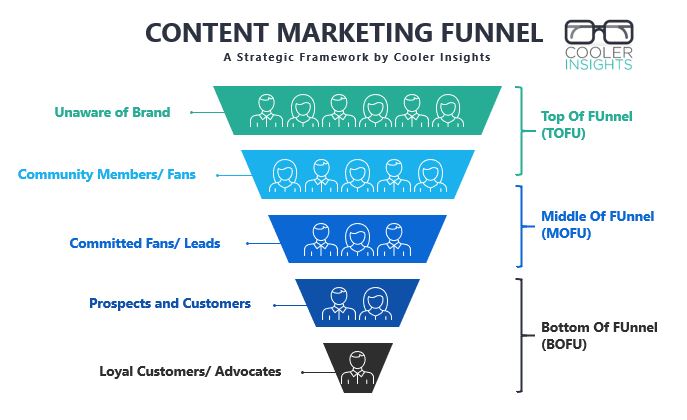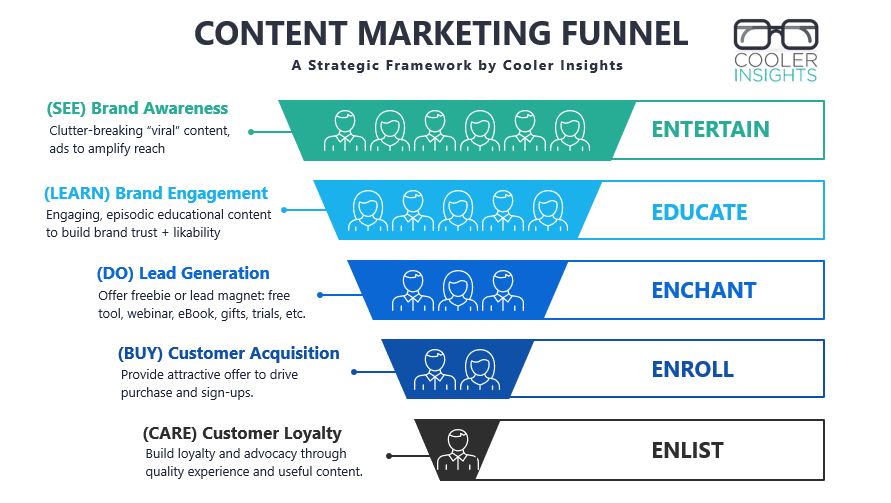
Wish to be more systematic in your content marketing efforts? Well, you need to start building a content marketing funnel.
But how do you do so and what content types should you craft for each stage of the funnel?
In this article, I will define what a content marketing funnel is, explain why you need to build one, and describe the five stages in a content marketing funnel.
I will also provide a template that you can use to build your own content marketing funnel, and recommend suitable content types that you can craft to meet different marketing goals at each stage of the funnel.
Funnels are a fundamental part of your content marketing strategy—brands often fail to meet their marketing goals when they haphazardly roll out their content without thinking about the best way to organise them.
Ready to ‘systematize’ your content marketing efforts and generate better ROI?
Let’s go!
Definition of a Content Marketing Funnel
First things first. What exactly is a Content Marketing Funnel anyway? Here’s how I would define it:
A Content Marketing Funnel is a systematic process describing the different phases, content strategies and tactics needed to flow your target audiences towards becoming a paid customer and brand advocate.
In most cases, a content marketing funnel can be segmented into 4 or 5 stages, depending on the customer types that you’re reaching out to. Here’s an example of how it may possibly look like.

There are two main parts of the funnel:
- Customer Types: From brand strangers (unaware of your brand) to ardent brand advocates, different target audiences require different content strategies and tactics to ‘graduate’ them to the next deeper level.
- TOFU, MOFU, and BOFU: These are acronyms for the different funnel stages. Top Of FUnnel (TOFU) strategies typically reach out to those new to your brand; Middle Of FUnnel (MOFU) strategies aim to deepen engagement and education; Bottom Of FUnnel (BOFU) strategies are targeted at conversion and building long-term loyalty.
Before we can determine the types of content that we should create for each customer stage, we need to understand what their concerns are.
Map Out Your Customer’s Buying Journey
Most of your customers aren’t Crazy Rich Asians. Thus, they often go through a process of fact-finding and research before they make a purchase.
Also known as your Customer Buying Journey, it is normally divided into five stages which looks like this:

Let’s look at each stage in detail:
- Need Recognition: Here, the customer may not know that she has a need or want that your brand or product can fulfill. Typically, she may be attracted to content that catches her eye, or that is relevant to a growing need.
- Research Options: Also known as the learning stage, she is actively looking for information to help her make a better purchase or to do better in life/ at work.
- Evaluate Brands: Comparisons between brands are made at this stage. Your prospect may also wish to test out the different options and learn more about them before committing her funds.
- Purchase: Before putting down her credit card or investing her company funds, she will want to look at all the fine-print—cost-benefit analyses, warranties, customer testimonials, reviews, and attractiveness of offers.
- Post Purchase: Depending on how the experience is like and the support provided by the brand, your customer may become a brand advocate (or not).
Map to Your Content Marketing Goals
Now that you’ve narrowed down what your customer needs at each buying stage, your overall marketing goal is to help them to draw closer and closer to your brand with increasingly valuable content.
This roughly maps onto your customer’s buying journey, ie:
- Need Recognition = Trigger Brand Awareness (SEE)
- Research Options = Increase Brand Engagement (LEARN)
- Evaluate Brands = Generate Leads (DO)
- Purchase = Acquire Customer (BUY)
- Post-Purchase = Build Customer Loyalty (CARE)
They’re also aligned to the TOFU, MOFU or BOFU stages of your content marketing funnel as shown below.

Let’s look at each of these Content Marketing Goals and stages in detail.
#1 Trigger Brand Awareness (SEE)
As your prospect doesn’t have an inkling of your brand, you need to break through the content clutter with entertaining (or edutaining) content. This could be achieved using the following content types:
- ‘Viral’ storytelling videos
- Contests and first-time promotions
- Short bite-sized tips
Often, online advertising through Google Ads, Facebook Ads or other channels are used to amplify your reach.
#2 Brand Engagement and Consideration (LEARN)
This is the second stage and your role is to educate them so that you can increase brand trust and likability. As education and learning can be a lengthy process, you should have a regular schedule of helpful content that aims to build a following. These could be deeper content pieces including:
- “How to” articles
- In-depth guides
- Regular video tutorials
#3 Lead Generation (DO)
At this third stage, you would have already built a community of brand fans. Your goal is to enchant some of them to become a part of your inner circle of members by providing highly valuable content. Hopefully, some of them may become paying customers later.
The content types here are normally gated content, and they may include:
- eBooks and guides
- Tools, templates and checklists
- Webinars
- Mini-courses and workshops
- Events
- Free Trial subscriptions
#4 Customer Acquisition (BUY)
Here, your goal is to enroll them to become paying customers, learners, members and subscribers. While customer acquisition may take place through a step-by-step process, it could also jump several stages depending on the attractiveness and relevance of your offer.
This is where you dangle carrots that may hopefully drive sales: discounts, packaged deals, bundle offers, bonuses, and other freebies to increase perceived customer value.
#5 Customer Loyalty (CARE)
Finally, in order to build brand loyalty and advocacy, you need to demonstrate care for your customers. Get them to feel like they’re part of a community or even a family. Enlist them to be your advocates and evangelists.
Doing so is probably the best thing you can do. In fact, it may cost five times more to acquire a new customer than to retain an existing one.
There are a couple of ways to do so:
- Provide the best Customer Experience that you can across your customer’s buying journey
- Produce content that specifically addresses customer problems and issues
- Build a cohesive and vibrant online community
Establish Content Marketing KPIs and Metrics
Now that you’ve put together a couple of content types and ideas for each stage of your content marketing funnel, you’ll need to measure how successful you are at each stage.
This can be done by establishing your content marketing metrics and KPIs at each stage:
- Brand Awareness: No of impressions, video views, reach, search ranking
- Brand Engagement: Engagement rates, likes, comments, shares, clicks and web sessions, duration, pages/viewed
- Lead Generation: No of leads, no of emails, no of event attendees, no of downloads
- Customer Acquisition: No of sales, value of sales (revenue), no of subscriptions, no of paid members
- Customer Loyalty: No of advocates, no of shares/retweets, 3rd party blog posts, customer lifetime value (LTV)
Here’s an example of how you can track these numbers from the top to the bottom of the funnel.

Conclusion
Creating and mapping out your content marketing funnel is one of the best things you can do.
It helps you to clearly identify what content pieces are needed at each stage of your customer’s buying journey, and establish the goals that they need to fulfill.
Doing so also helps you to ascribe specific KPIs and metrics to each content stage, and determine your “funnel flow”—how many individuals make it through each stage, and how many of them dropped off. This can be done through using a tool like Google Analytics.
Now that you’ve learned how to build a content marketing funnel, your next step is to put it into action. Let me know what challenges you face in doing so—drop it in the comments box below.
Need Help with Your Content Marketing?
With over 5 years of experience working with over 65 clients while equipping over 3,200 trainees in social media and content marketing skills, Cooler Insights has the knowledge, experience and expertise to help you win in the online world.
Drop us an an email with your particulars or fill up our contact form below—we’ll be happy to arrange for a free 60-minute consultation session.

Great information man! Well put. I grew up with internet and social media, yet I’m still late to the content marketing game(I’m 35) . I always thought I understood it, but chose not to go that direction yet. Now that i have decided to jump in I realize how much the whole concept has grown! It’s evolved its own curriculum, it’s own science! Which is amazing . So a person with the right knowledge and if it is applied correctly then it seems like a recipe for success. Very enlightening. I’m trying hardest to build my network before I go full throttle. Thanks